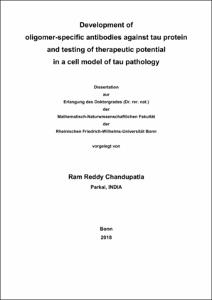Development of oligomer-specific antibodies against tau protein and testing of therapeutic potential in a cell model of tau pathology

Development of oligomer-specific antibodies against tau protein and testing of therapeutic potential in a cell model of tau pathology

| dc.contributor.advisor | Mandelkow, Eckhard | |
| dc.contributor.author | Chandupatla, Ram Reddy | |
| dc.date.accessioned | 2020-04-27T13:09:27Z | |
| dc.date.available | 2020-04-27T13:09:27Z | |
| dc.date.issued | 15.04.2020 | |
| dc.identifier.uri | https://hdl.handle.net/20.500.11811/8245 | |
| dc.description.abstract | Tau, a microtubule associated protein, forms abnormal aggregates in many neurodegenerative diseases such as Alzheimer disease (AD). There is an urgent need for disease-modifying therapies of AD and related tauopathies. Inhibiting the aggregation of tau and the accumulation of neurofibrillary tangles (NFTs) could be helpful in combating tau pathology. Recent studies show that tau induced toxicity is mainly due to the presence of oligomers of tau rather than the monomers and fibrillar aggregates (Kaniyappan et al., 2017, Flach et al., 2012, Lasagna-Reeves et al., 2010). To combat the toxicity of tau oligomers we developed antibodies against the purified low-n tau oligomers (dimers to hexamers) of TauRDΔK, the strongly aggregating repeat domain of tau. Monoclonal antibodies were tested by various biochemical and biophysical methods for their specificity to bind to the toxic oligomers. Some antibodies show specificity to aggregates of tau while others detect all forms of tau. Antibodies 2B10 and 6H1, described as representative examples, bind to tau oligomers with high specificity as judged by dotblot, dynamic light scattering (DLS) and immunofluorescence analysis. As these antibodies are dependent on tau conformations, they appear non-specific in denaturing methods like western blotting. 2B10 and 6H1 antibodies are able to inhibit the tau aggregation up to ~90% in vitro (TauRDΔK, hTauP301L), as judged by the Thioflavin S fluorescence assay which is sensitive to ß-structure. In the presence of antibodies tau protein forms only up to low-n oligomers as judged by light scattering and atomic force microscopy (AFM). The choice of the pH of the column elution buffer of the antibodies plays a key role in determining the activity of the antibodies, as antibodies eluted at low pH have a higher activity compared to the same antibodies eluted at high pH. The ability of antibodies to inhibit the aggregation of tau was tested in an N2a cell model of tau pathology which expresses the pro-aggregant tau repeat domain TauRDΔK. Antibodies were added to the extracellular medium, without or with protein transfection reagent (Xfect) which stimulates cellular uptake. In this assay, 2B10 antibody failed to inhibit tau aggregation (ThS signal) and failed to prevent aggregation induced apoptosis (Annexin V signal). By contrast, in the split-luciferase complementation assay the antibody 2B10, applied extracellularly, was able to prevent the dimerization/oligomerization of tau. Surprisingly this antibody has only a relatively low affinity to tau but is still very active in inhibiting tau aggregation in vitro. Antibodies added extracellularly were taken up by the cells and sorted into lysosomes. Their inhibitory effect can be explained by the fact that the internalized antibody recruits the toxic tau protein or oligomers to the lysosomes for degradation. In summary, a subset of antibodies raised against the purified low-n oligomers of TauRDΔK are able to inhibit tau aggregation both in vitro and in a cell model of tau pathology. | en |
| dc.language.iso | eng | |
| dc.rights | In Copyright | |
| dc.rights.uri | http://rightsstatements.org/vocab/InC/1.0/ | |
| dc.subject.ddc | 570 Biowissenschaften, Biologie | |
| dc.title | Development of oligomer-specific antibodies against tau protein and testing of therapeutic potential in a cell model of tau pathology | |
| dc.type | Dissertation oder Habilitation | |
| dc.publisher.name | Universitäts- und Landesbibliothek Bonn | |
| dc.publisher.location | Bonn | |
| dc.rights.accessRights | openAccess | |
| dc.identifier.urn | https://nbn-resolving.org/urn:nbn:de:hbz:5-55032 | |
| ulbbn.pubtype | Erstveröffentlichung | |
| ulbbnediss.affiliation.name | Rheinische Friedrich-Wilhelms-Universität Bonn | |
| ulbbnediss.affiliation.location | Bonn | |
| ulbbnediss.thesis.level | Dissertation | |
| ulbbnediss.dissID | 5503 | |
| ulbbnediss.date.accepted | 24.04.2019 | |
| ulbbnediss.institute | Angegliederte Institute, verbundene wissenschaftliche Einrichtungen : Deutsches Zentrum für Neurodegenerative Erkrankungen (DZNE) | |
| ulbbnediss.fakultaet | Mathematisch-Naturwissenschaftliche Fakultät | |
| dc.contributor.coReferee | Hoch, Michael |
Dateien zu dieser Ressource
Das Dokument erscheint in:
-
E-Dissertationen (4442)




